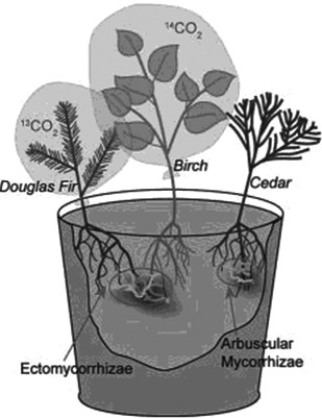Use the following information to answer the question.
Suzanne Simard and colleagues knew that the same mycorrhizal fungal species could colonize multiple types of trees. They wondered if the same fungal individual would colonize different trees, forming an underground network that potentially could transport carbon and nutrients from one tree to another (S. Simard et al. 1997. Net transfer of carbon between mycorrhizal tree species in the field. Nature 388:579-82) .
Pots containing seedlings of three different tree species were set up and grown under natural conditions for three years (Fig. A) . Two of the three species (Douglas fir, birch) could form ectomycorrhizal connections with the same fungal species, but the third species (cedar) could not form an ectomycorrhizal connection with the fungal species. In some of the pots, the researchers placed airtight bags over the Douglas fir and birch seedlings and injected carbon dioxide made from carbon-13 into the bags with the Douglas fir and carbon dioxide made from carbon-14 into the bags with the birch. (13C and 14C are different isotopes of carbon that can be detected and measured by researchers.) As the seedlings photosynthesized, the carbon dioxide was converted into sugars that could be tracked and measured by the researchers. The researchers measured whether the sugars in each plant contained only the carbon isotope that was in the air of their plastic bag or also the carbon isotope from the air around the other plant.
Figure A
Referring to Simard et al. (1997) , which design element is the control in this experiment and why?
Definitions:
Tilman Riemenschneider
An influential German sculptor and woodcarver of the late Gothic period, renowned for his intricate altarpieces and religious figures.
Donor Portraits
Donor portraits are artworks, particularly seen in medieval and Renaissance art, depicting individuals who commissioned or donated the artwork as a way of displaying piety and patronage, often integrated into religious scenes.
Disguised Patronage
A concept in art where the sponsor of the artwork is included within the piece, often cleverly integrated into the scene.
Triptych
A three-paneled painting, ivory plaque, or altarpiece. Also, a small, portable shrine with hinged wings used for private devotion.
Q4: A lateral root originates in the _.<br>A)
Q7: One should expect to find cilia associated
Q32: Which of the following pairs of protists
Q36: In onions (Allium), cells of the sporophyte
Q37: You find a new species of worm
Q53: Soft-shell crab is a prized dish in
Q57: If additional DNA sequence evidence shows that
Q61: Which of these statements accurately describes a
Q66: With which of the following statements would
Q78: Use the information to answer the following